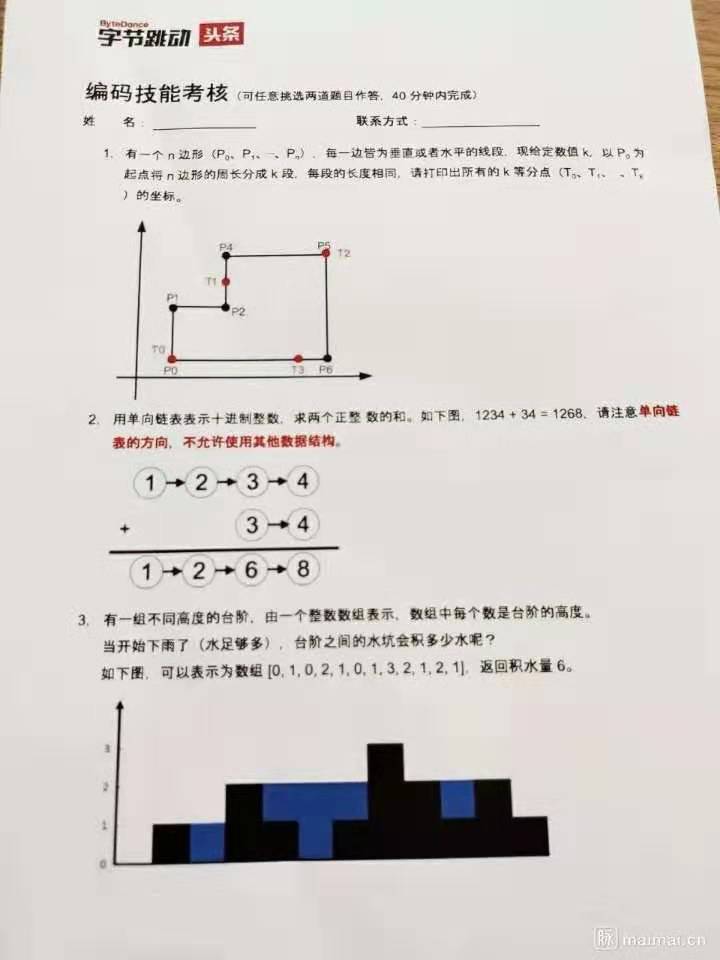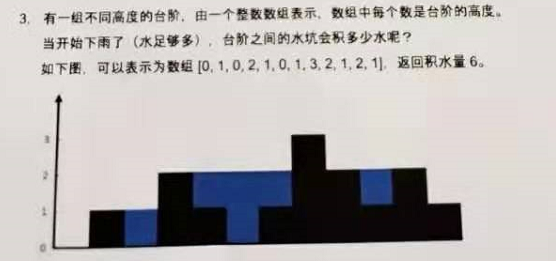

无聊系列 - 字节跳动的三道编码面试题的实现 - 冲杀 - 博客园
source link: https://www.cnblogs.com/chongsha/p/11701445.html?
Go to the source link to view the article. You can view the picture content, updated content and better typesetting reading experience. If the link is broken, please click the button below to view the snapshot at that time.
国庆节后,自己的一个小圈子微信群的伙伴们发了一张图片,是网上流传的字节跳动的面试题编码,闲的无事就思索了下,发现都不难,都是对基础的数学知识的考量。先上图吧!
当然40分钟,我也无法把任意两题编码完成,只是知道大概的解题思路,唯一能确定的,在面试规定时间内,第二题我是肯定可以在20分钟内编码完成。

题目一

基础知识就是初中的平面直角坐标系,解析思路:
- 计算总周长;
- 将各边长的前后坐标计算出来封装好,第四步要使用;
- 根据K段值计算出平均分段后的长度;
- 然后循环K次,根据平均长度依次相加计算等分点的坐标。
不多说,上代码:
先定义坐标的Point类
class Point {
float x;
float y;
public Point() {
}
public Point(float x, float y) {
this.x = x;
this.y = y;
}
public Point(Point point) {
this(point.x, point.y);
}
@Override
public String toString() {
return "Point, x:" + x + " y:" + y;
}
}
N边形的边封装类
class Line {
Point begin;
Point end;
float length;
public Line() {
}
public Line(Point begin, Point end, float length) {
this.begin = begin;
this.end = end;
this.length = length;
}
}
现在上实现计算的类
这段代码第一个版本的时候,在正方形偶数等分的时候,坐标点计算不准确,今晚上看着代码思考了10分钟的样子,稍微改动了下,暂时没有这个bug了。其他的bug,期待大家一起发现,然后修复吧!
public class Polygon {
/**
* 计算边的长度
*
* @return
*/
private static float lineLength(Point a, Point b) {
float length;
if (a.x == b.x) {
// 垂直线条
length = Math.abs(a.y - b.y);
} else {
length = Math.abs(a.x - b.x);
}
return length;
}
/**
* 计算 周长
*
* @return
*/
private static float totalSideLength(Point[] points, Line[] lines) {
float side = 0;
for (int i = 1; i < points.length; i++) {
Point prev = points[i - 1];
Point point = points[i];
float length = lineLength(prev, point);
side += length;
lines[i - 1] = new Line(prev, point, length);
if (i == points.length - 1) {
length = lineLength(point, points[0]);
side += length;
lines[i] = new Line(point, points[0], length);
}
}
return side;
}
public static Point[] division(Point[] points, int divisionNum) {
Point[] divisionPoint = new Point[divisionNum];
// 计算周长
Line[] lines = new Line[points.length];
float side = totalSideLength(points, lines);
// 等分长度
float divisionLength = side / divisionNum;
int lineIndex = -1;
float sumLength = 0;
for (int i = 0; i < divisionNum; i++) {
if (i == 0) {
// 第一个等分点直接是起始点坐标
divisionPoint[i] = new Point(points[0]);
continue;
}
divisionPoint[i] = new Point();
float lineLength = divisionLength * i;
while (true) {
Line line;
if (sumLength < lineLength) {
lineIndex++;
line = lines[lineIndex];
sumLength += line.length;
} else
line = lines[lineIndex];
if (sumLength >= lineLength) {
float temp = sumLength - lineLength;
if (line.begin.x == line.end.x) {
// begin和end的坐标点垂直
divisionPoint[i].x = line.begin.x;
if (line.end.y > line.begin.y)
divisionPoint[i].y = line.end.y - temp;
else
divisionPoint[i].y = line.end.y + temp;
} else {
// begin和end的坐标点水平
divisionPoint[i].y = line.end.y;
if (line.end.x > line.begin.x)
divisionPoint[i].x = line.end.x - temp;
else
divisionPoint[i].x = line.end.x + temp;
}
break;
}
}
}
return divisionPoint;
}
private static void print(Point[] points) {
for (int i = 0; i < points.length; i++) {
System.out.println("第" + (i + 1) + "等分点, x:" + points[i].x + ",y:" + points[i].y);
}
}
public static void main(String[] args) {
Point[] points = new Point[] { new Point(0, 0), new Point(0, 1), new Point(1, 1), new Point(1, 0) };
Point[] divPoints = division(points, 8);
print(divPoints);
}
}
题目二

解题思路:
对应位数的数字相加,永远不会超过18,所以,我们就先把对应位置的和计算出来,然后再反复循环找到大于9的数,向高位进位。
这个比较简单,只是考察个位数的正整数加法永远不大于18这个细节。
public class LinkAddition {
static class NumNode {
public int num;
public NumNode next;
public NumNode() {
}
public NumNode(int num) {
this.num = num;
};
public NumNode(int num, NumNode next) {
this(num);
this.next = next;
}
}
private static int length(NumNode num) {
int length = 0;
NumNode temp = num;
while (temp != null) {
length++;
temp = temp.next;
}
return length;
}
private static NumNode calc(NumNode a, NumNode b, int aLength, int bLength) {
NumNode aNode = a;
NumNode bNode = b;
NumNode result = new NumNode();
NumNode resultNode = result;
// 计算b链表再a中的起始索引
int aStartIndex = aLength - bLength;
for (int i = 0; i < aLength; i++) {
if (i >= aStartIndex) {
resultNode.num = aNode.num + bNode.num;
bNode = bNode.next;
} else
resultNode.num = aNode.num;
aNode = aNode.next;
if (aNode != null) {
resultNode.next = new NumNode();
resultNode = resultNode.next;
}
}
return result;
}
public static NumNode addition(NumNode a, NumNode b) {
NumNode result = null;
// 计算位数
int aLength = length(a);
int bLength = length(b);
if (aLength > bLength) {
result = calc(a, b, aLength, bLength);
} else {
result = calc(b, a, bLength, aLength);
}
boolean isGreater9 = true;
while (isGreater9) {
isGreater9 = false;
NumNode node = result;
while (node != null) {
// 检查是否有大于9的节点
if (node.num > 9) {
isGreater9 = true;
break;
}
node = node.next;
}
// 没有大于9且需要进位的节点
if (!isGreater9)
break;
node = result;
if (node.num > 9) {
// 头节点的内容跟大于9,需要进位
result = new NumNode(1, node);
node.num = node.num - 10;
}
while (node.next != null) {
if (node.next.num > 9) {
node.num += 1;
node.next.num = node.next.num - 10;
}
node = node.next;
}
}
return result;
}
private static void print(NumNode num) {
NumNode node = num;
while (node != null) {
System.out.print(node.num);
node = node.next;
}
}
public static void main(String[] args) {
NumNode a = new NumNode(9);
a.next = new NumNode(9, new NumNode(9));
NumNode b = new NumNode(9);
// b.next = new NumNode(9, new NumNode(9));
NumNode result = addition(a, b);
print(result);
}
}
题目三

这个我写的第一个版本,只契合类那个举例,然后瞬间就被我推翻类,最后坐下思考类10分钟,把这个按照二维数组的思路解析了。
先找到最高处,然后就以最高处为一个维度,做循环计算出水量,还是上代码吧:
public class Water {
public static int waterNum(int[] steps) {
int waterNum = 0;
int max = steps[0];
for (int i = 1; i < steps.length; i++) {
if (max < steps[i])
max = steps[i];
}
for (int i = 0; i < max; i++) {
int num = 0, index = 0;
for (int n = 0; n < steps.length; n++) {
if (steps[n] - i > 0) {
if (num > 0) {
waterNum += n - index - 1;
}
num = steps[n] - i;
index = n;
}
}
}
return waterNum;
}
public static void main(String[] args) {
int[] steps = new int[] { 0, 1, 0, 2, 1, 0, 1, 3, 2, 1, 2, 3, 0, 1 };
int water = waterNum(steps);
System.out.println(water);
}
}
总结:
其实这几题本身的知识点并不难,都是平时用到的,就看怎么转化为代码罢了。
第一题考察的直角坐标系上怎么计算边长,然后根据均分等长从第一条边挨着走,计算对应的坐标,该知识点在初中就已学过。
第二题则是考察每位上的正整数加法到底最大能到多少,只要明白了这一点,把每一位上相加后,再统一做进位处理就可以了。
第三题的代码量是最少的,我的解题思路是二位数组的方式, 也不算难。
Recommend
About Joyk
Aggregate valuable and interesting links.
Joyk means Joy of geeK